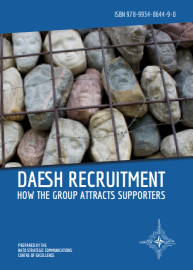DAESH RECRUITMENT - HOW THE GROUP ATTRACTS SUPPORTERS
DAESH RECRUITMENT - HOW THE GROUP ATTRACTS SUPPORTERS
Author(s): Rafal Zgryziewicz
Contributor(s): Anna Reynolds (Editor), Linda Curika (Editor)
Subject(s): Politics / Political Sciences, Politics, Social Sciences, Economy, Psychology, Media studies, Communication studies, Sociology, Social psychology and group interaction, Methodology and research technology, Studies in violence and power, ICT Information and Communications Technologies, Peace and Conflict Studies
Published by: NATO Strategic Communications Centre of Excellence
Keywords: Daesh; extremist groups; recruiting methods; supporters; media; communication; Islamic State; Jihad;
Summary/Abstract: To be successful, an organization must have a carefully prepared strategy communicated through the proper channels, which leads to the implementation of actions that will result in the desired end state. The process used to achieve coherence between communication and information activities, closing the gap between words, visuals, and actions is known as strategic communication. In order to be effective, strategic communication must involve both charismatic leaders and active communicators. A well thought out recruitment campaign is essential to identifying and acquiring sufficient human resources. Recruitment is a function of human resource management and refers to the process of attracting, selecting, and appointing suitable candidates for specific positions within an organisation. Just as legally operating institutions choose the best people they can find to fulfil specific needs, organized crime and terrorist organizations must recruit people to carry out their plans. The main goal is to attract the attention of potential audiences and draw them into the organisation, either regionally or globally. Daesh has been working in its strategic communications to attract the attention of people who may be willing to support Abu Bakr Al-Baghdadi’s ideology. Daesh youth recruitment has history of its own, which is as old as the organization itself. Their approach to recruitment plays a vital role in sustaining the number of foreign terrorist fighters and many other kinds of supporters who are an essential part of the overall strategy. If we only think of Daesh recruits as foreign fighters, we are not thinking broadly enough. Of course, any recruit could potentially become a foreign or domestic fighter. A ‘foreign fighter’ is a terrorist who comes from any country other than Syria and Iraq to support Daesh in battle. However, it is important to keep in mind that the recruitment campaign is not reserved only for those who choose to fight. The campaign targets many other audiences, including those who stay in their own countries and support Daesh by executing a great many tasks necessary for the operation of the organisation. Therefore, to understand the communication strategy of the terrorists, we must first understand how Daesh wants to be supported and what motivates possible Daesh recruits. This study focuses on the ‘Support Line of Effort’ mentioned in the previous report on Daesh published by the NATO StratCom CoE. The main objectives of this report are to show who is a potentially target for Daesh recruitment, what motivates people to support Daesh, and to identify the steps recruiters take to secure new members. The Centre has been analysing Daesh products on a monthly basis. These monthly assessments have been used to calculate what percentage of the overall communication strategy is dedicated to recruitment support. They also provide some indication of what steps are being taken and what techniques Daesh has been using to staff its terrorism and intimidation projects.
- Print-ISBN-13: 978-9934-8644-9-0
- Page Count: 64
- Publication Year: 2016
- Language: English
- eBook-PDF
- Table of Content
- Introduction
- Sample-PDF

